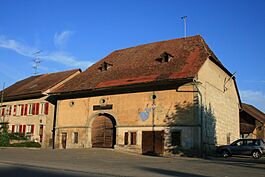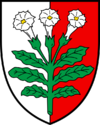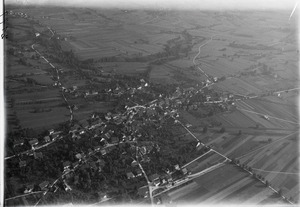Corcelles-près-Payerne facts for kids
Quick facts for kids
Corcelles-près-Payerne
|
||
|---|---|---|

Corcelles-près-Payerne village
|
||
|
||
| Country | Switzerland | |
| Canton | Vaud | |
| District | Broye-Vully | |
| Area | ||
| • Total | 12.12 km2 (4.68 sq mi) | |
| Elevation | 454 m (1,490 ft) | |
| Population
(Dec 2020 )
|
||
| • Total | 2,683 | |
| • Density | 221.37/km2 (573.3/sq mi) | |
| Postal code |
1562
|
|
| Surrounded by | Belmont-Broye (FR), Grandcour, Missy, Montagny (FR), Payerne, Vallon (FR) | |
Corcelles-près-Payerne is a small town, also called a municipality, in Switzerland. It is located in the canton of Vaud, within the Broye-Vully area. This charming place is known for its quiet life and beautiful surroundings.
Contents
History of Corcelles-près-Payerne
Corcelles-près-Payerne was first mentioned in official records way back in 1235. Back then, it was known as Corsales. This shows that the town has a long history, stretching over many centuries.
Geography of Corcelles-près-Payerne
Corcelles-près-Payerne covers an area of about 12.13 square kilometers (4.68 square miles). A large part of this land, about 82.5%, is used for farming. This means you'll see many fields and farms around the town.
About 4.4% of the area is covered by forests. This provides nice green spaces and natural habitats. The town itself, with its buildings and roads, takes up about 10.9% of the land. Rivers and lakes make up 1.6% of the area.
The municipality used to be part of the Payerne District. However, in 2006, it became part of the new Broye-Vully district. The town is located along an old highway that leads towards Bern. Over time, Corcelles-près-Payerne has grown closer to the nearby town of Payerne.
Coat of Arms
The coat of arms for Corcelles-près-Payerne has a special design. It is split down the middle into two colors: silver (or white) on one side and red on the other. On top of these colors, there is a picture of a tobacco plant. This plant is shown in its natural colors.
People of Corcelles-près-Payerne
Corcelles-près-Payerne has a population of about 1,802 people. A small part of the population, around 15.7%, are people from other countries. Over the last ten years, the number of people living here has grown by about 15.5%.
Most people in Corcelles-près-Payerne speak French, which is about 89.1% of the population. German is the second most common language, spoken by about 5.5% of the people. A smaller number of people speak Portuguese or Italian.
Many people living in Corcelles-près-Payerne were born there, about 35.6%. Others were born in the same canton (state) of Vaud, or in other parts of Switzerland. About 12.5% of the residents were born outside of Switzerland.
The town has a good mix of age groups. About 12.0% of the population are young children (0-9 years old). Teenagers (10-19 years old) make up about 13.3%. Adults aged 20-59 make up a large portion of the population, around 53.6%. Older adults and seniors (60 years and older) make up about 20.6% of the population.
Most households in the town have an average of 2.3 people. There are many single-person households, and also families with children.
The population of Corcelles-près-Payerne has changed over time:

Economy of Corcelles-près-Payerne
In Corcelles-près-Payerne, people work in different types of jobs. The unemployment rate is quite low, around 3.2%.
Many people work in the primary sector, which includes jobs like farming and forestry. There are about 43 businesses in this area. The secondary sector includes jobs in manufacturing and construction. There are 23 businesses in this sector.
The tertiary sector covers jobs in services. This includes things like sales, transportation, hotels, restaurants, education, and healthcare. There are 40 businesses in this sector. Overall, about 40% of the workforce in Corcelles-près-Payerne are women.
Many people who live in Corcelles-près-Payerne travel to other towns for work. About 65.4% of working people use a private car to get to their jobs. A smaller number, 7.7%, use public transportation.
Religion in Corcelles-près-Payerne
According to a census from 2000, about 54.6% of the people in Corcelles-près-Payerne belong to the Swiss Reformed Church. Another 30.5% are Roman Catholic.
There are also smaller groups of people who belong to other Christian churches or are Islamic. About 6.02% of the population do not belong to any church, or are agnostic or atheist.
Education in Corcelles-près-Payerne
Education is important in Corcelles-près-Payerne. About 37% of the population have finished high school (upper secondary education). Around 9.7% have gone on to higher education, like a university or a specialized college.
In the 2009/2010 school year, there were 278 students in the local school district. The canton (state) of Vaud provides two years of optional pre-school. The primary school program lasts for four years, and there were 153 students in primary school.
After primary school, students go to lower secondary school for six years. There were 122 students in these schools. A few students are also home-schooled or attend other types of schools. While some students from other towns come to school in Corcelles-près-Payerne, many residents travel to schools outside the municipality.
Transportation in Corcelles-près-Payerne
Corcelles-près-Payerne has two train stations, which makes it easy to travel. These are Corcelles-Nord and Corcelles-Sud.
From these stations, you can catch trains to several important cities. These include Lausanne, Kerzers, Fribourg/Freiburg, and Yverdon-les-Bains. This helps people get around for work, school, or fun.
See also
 In Spanish: Corcelles-près-Payerne para niños
In Spanish: Corcelles-près-Payerne para niños





